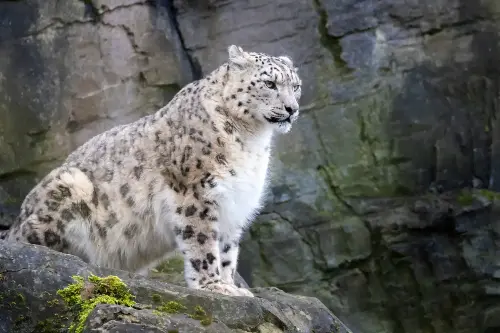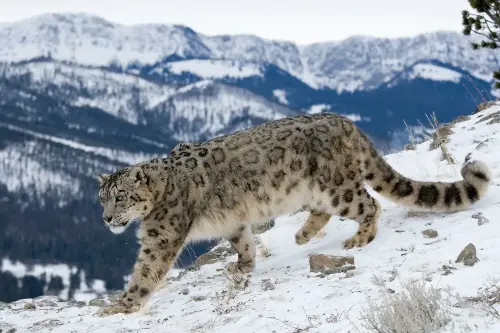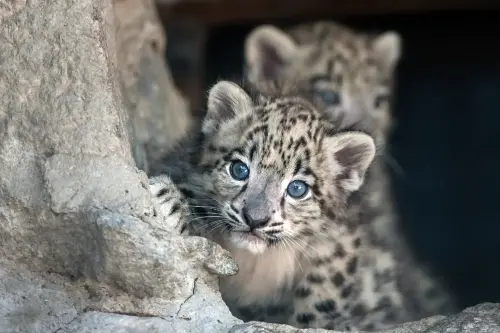Residing in the rocky mountain ranges of Central and South Asia, the snow leopard is a marvel of evolution, perfectly designed for its harsh and lofty habitat. Often referred to as the 'Ghost of the Mountains', this elusive feline has developed a suite of exceptional adaptations that enable it to thrive at altitudes where air is thin and cold is severe.

Adaptations for an Alpine Existence
Snow leopards are a testament to nature's ingenuity—their physical characteristics are tailor-made for survival in their rugged environment. With long, powerful hind limbs, they can leap up to six times the length of their body, a skill necessary for navigating the steep, rocky terrain of their alpine homes. Their large, furry paws act as snowshoes to distribute weight and provide grip on icy surfaces.
Perhaps one of the most distinctive features of the snow leopard is its luxuriously thick fur. This dense coat, dappled with a unique pattern of black rosettes on a smoky grey background, provides superb insulation against the plummeting temperatures of their high-altitude range. This pattern is not just for warmth; it plays a crucial role in their stealth. The spots provide near-perfect camouflage against the rugged landscape, aiding them in their solitary hunts.
Remarkable Hunting Strategies
Snow leopards are apex predators and, as such, have evolved sophisticated hunting techniques to capture prey in difficult terrain. They are predominantly crepuscular, preferring to hunt at dawn and dusk when their vision—six times better than that of a human—gives them the upper edge in low-light settings.

Prey such as the nimble-footed ibex and the Bharal, or blue sheep, stand little chance against the snow leopard's strategic prowess. These big cats prefer to ambush their prey, using their camouflaged fur to blend into the environment before making a surprise pounce. Snow leopards can take down animals three times their size, a testament to their prodigious strength and skill.
Benevolent Solitude
Unlike other big cats, snow leopards lead relatively non-aggressive lives, choosing to live in solitude across vast territories that can span up to 100 square kilometers. Their solitary nature is not just preference but necessity, as the sparse prey availability in the mountains means they cannot afford the competition that comes from living in groups.
To communicate across these wide expanses, snow leopards have a range of vocalisations, including a unique puffing sound called 'chuffing'. This sound, along with scrapes, scent marks, and faeces, acts as their version of a social media network, leaving messages for potential mates or warning off competitors without the need for direct confrontation.
Survival in the Snow
Reproduction for the snow leopard is a delicate affair, with females giving birth to one to five cubs every two to three years. The cubs are born blind and helpless, relying entirely on their mother for warmth and nourishment in their den of thick fur and grass. Due to the harsh conditions of their habitat, mortality rates are high, making each successful rearing of cubs a vital contribution to the survival of the species.

Conservation of a Vulnerable Species
Despite their incredible adaptations and the reverence they command as a symbol of the wilderness, snow leopards are facing numerous threats. They are currently listed as a vulnerable species by the International Union for Conservation of Nature (IUCN), with an estimated population of fewer than 10,000 mature individuals left in the wild.
One of the major threats to snow leopards is habitat loss due to mining and infrastructure development, which fragments their natural homes. They are also at risk from poaching, their pelts a prized possession in illegal wildlife trade, and their body parts used in traditional medicine. Climate change, too, is a looming threat, as it threatens the fragile ecosystems of the high mountains.
Efforts by conservationists worldwide are increasing awareness and striving to protect these magnificent creatures. Through initiatives such as anti-poaching patrols, community-based conservation programs, and researching and monitoring populations, there is hope for the survival of the species.
In the realm of elusive predators, the snow leopard reigns supreme. Its adaptations not only reveal the wonders of evolutionary design but also underscore the intrinsic value of biodiversity and the necessity of continuous conservation efforts. These 'Ghosts of the Mountains', with their mystical presence and breathtaking beauty, are not just survivors of elevated terrains but symbols of the wild, untamed spirit of nature that we must cherish and safeguard.
